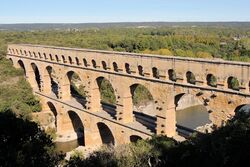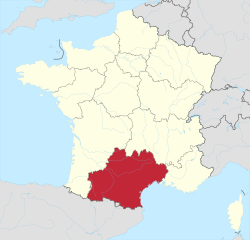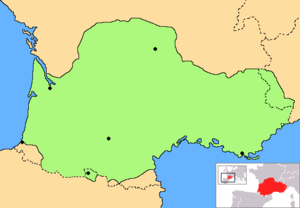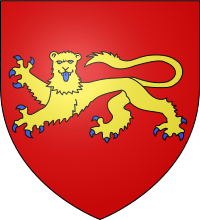أوكسيتانيا (منطقة إدارية)
Occitanie
Occitània | |
|---|---|
 | |
 | |
| البلد | |
| عاصمة الإقليم | تولوز |
| الأقاليم | |
| الحكومة | |
| • الرئيس | كارول دلگا (الحزب الاشتراكي) |
| المساحة | |
| • الإجمالي | 72٬724 كم² (28٬079 ميل²) |
| التعداد (2015) | |
| • الإجمالي | 5٬774٬185 |
| • الكثافة | 79/km2 (210/sq mi) |
| صفة المواطن | Occitans |
| منطقة التوقيت | UTC+1 (CET) |
| • الصيف (التوقيت الصيفي) | UTC+2 (CEST) |
Occitanie (بالفرنسية: [ɔksitani] (![]() استمع)؛ أوكسيتان: Occitània [utsiˈtanjɔ]; قطلان: Occitània [uksiˈtaniə]) أو Occitania[1] هي منطقة ادارية فرنسية، أنشئت في 1 يناير 2016 من المنطقتين الفرنسيتين السابقتين لانگدوك-روسيون و ميدي-پيريني. وقد أقر مجلس الدولة الفرنسي "أوكسيتاني" اسماً جديداً للمنطقة في 28 سبتمبر 2016، ليسري في 30 سبتمبر 2016.[2]
استمع)؛ أوكسيتان: Occitània [utsiˈtanjɔ]; قطلان: Occitània [uksiˈtaniə]) أو Occitania[1] هي منطقة ادارية فرنسية، أنشئت في 1 يناير 2016 من المنطقتين الفرنسيتين السابقتين لانگدوك-روسيون و ميدي-پيريني. وقد أقر مجلس الدولة الفرنسي "أوكسيتاني" اسماً جديداً للمنطقة في 28 سبتمبر 2016، ليسري في 30 سبتمبر 2016.[2]
تعد وسط منطقة سيبتمانيا (سبعة مدائن) إبان الفتح العربي للمنطقة,
المنطقة الادارية الحديثة مسماة على اسم المنطقة الثقافية والتاريخية أوكسيتانيا، التي تغطي مساحة أكبر. المنطقة، كما هي اليوم، تغطي مساحة مشابهة لتلك التي حكمها كونتات تولوز في القرنين 12 و 13. راية كونتات تولوز، المعروفة شعبياً بإسم الصليب الأوكسيتاني، تستخدمها المنطقة الحديثة وهي أيضاً رمز ثقافي ذو شعبية.
تغطي المنطقة الجديدة مساحة تزيد عن 72,724 كم²، وتعداد سكانها 5,626,858 نسمة.[3] وتحد أكيتان الجديدة و أوڤرن-رون-ألپ, پروڤنس-ألپ-كوت دازور، أندورا (Canillo, Encamp و La Massana و أوردينو) و اسبانيا (أراگون و قطالونيا)
أسماء الأماكن
Enacted in 2014, the territorial reform of the French regions had been subject to debate for many years.[4]
The reform law used as the new region's provisional name the hyphenated names of its predecessors: لانگدوك-روسيون و ميدي-پيريني, in alphabetical order. As for most of the merged regions, a permanent name was then proposed by the new regional council to replace that provisional name.[5][6][7] On June 24, 2016, the regional assembly of Languedoc-Roussillon-Midi-Pyrénées adopted the name Occitanie after lengthy public consultation.[8] The provisional name of the region was withdrawn on September 30, 2016, when the new name took effect.[2]
Occitanie, the new name, derives from the historical appellation of the broader region, and refers to the historical use throughout that territory of the Occitan language and its various dialects, which are so named for the word òc, the equivalent of "yes".
The c. 450,000 French Catalans living in the region (or Catalans of the North, as they mostly call themselves) expressed dismay at the regional assembly resolution, regarding the new name as ignoring their presence.[9] On September 10, 2016, some 10,000 people (7,800 according to the police) demonstrated in Perpignan, demanding that the merged region name contain the words Pays Catalan (Catalan land).[10]
الأقاليم
| Code | Arms [1] | الإقليم | العاصمة | على اسم | التعداد (2013) |
|---|---|---|---|---|---|
| 09 | أرياج | Foix | أرياج (نهر) | 152,684 | |
| 11 | أود | كركاسون | أود (نهر) | 364,877 | |
| 12 | أڤيرون | Rodez | أڤيرون (نهر) | 277,740 | |
| 30 | گار | نيم | گاردون (نهر) | 733,201 | |
| 31 | الگارون الأعلى | تولوز | گارون (نهر) | 1,298,562 | |
| 32 | جرس | أوش | Gers (river) | 190,276 | |
| 34 | إرو | مونپلييه | إرو (نهر) | 1,092,331 | |
| 46 | لو | قاورش | لو (نهر) | 173,758 | |
| 48 | لوزار | Mende | مون لوزار | 76,607 | |
| 65 | الپرانس العليا | تارب | الپرانس | 228,868 | |
| 66 | الپرانس الشرقية | پرپينيان | الپرانس | 462,705 | |
| 81 | تارن | آلبي | تارن (نهر) | 381,927 | |
| 82 | تارن وگارون | مونتوبان | نهرا تارن و گارون | 250,342 |
التجمعات السكنية الرئيسية
- تولوز (466,297)
- مونپلييه (272,084)
- Nîmes (150,564)
- Perpignan (120,959)
- Béziers (74,811)
- Montauban (57,921)
- آلبي (49,475)
الثقافة
الهوية التاريخية
 منطقة أوكسيتاني ضمن الحيز الأوكسيتاني (الخط الأحمر). |
 خريطة المنطقة الجديدة مع أقاليمها الثلاثة عشر، ملونة حسب المقاطعات التاريخية كما كانوا حتى 1790. |
|---|
The new administrative region includes provinces and territories of diverse cultural and historical origin: Languedoc (High and Low Languedoc), Països Catalans (Roussillon, Cerdanya, Vallespir, Conflent, Capcir), the County of Foix, and the eastern parts of what was formerly Gascony (Armagnac, Comminges, Couserans, Bigorre, Condomois, Nébouzan, Rivière-Verdun), and Guiana (Carcin, Roergue). During the Ancien Régime, most of these territories lay within the jurisdiction of the Parlement of Toulouse, founded in 1443.
أوكسيتانيا
أوكسيتانيا[11] (Occitània[12] or Óucitanìo[13] in Occitan) is a historical region[14][15][16] of southwestern Europe in which Occitan was the main vernacular language. This territory was already united, in Roman times first as the Diocese of Vienne and then as the Seven Provinces (Septem Provinciae)[17]), and in Aquitaine at the beginning of the Middle Ages[18] (Aquitanica, Visigoth kingdom of Toulouse[19]), before the Frankish conquest. Occitania is characterized by "the Occitan culture", since the Middle Ages another expression of Romance culture in France and to a lesser extent in Italy, Spain and Monaco.[20] It is presented and recognized on institutional sites of French communities, such as those of the Lot-et-Garonne County Council[21] and the city of Agen.[22]
لانگدوك

Most of the territory that came to be called Languedoc (the region where langue d'oc is spoken; in Occitan Lengadòc, تُنطق [ˌleŋɡɔˈðɔ(k)]) became attached to the Kingdom of France in the 13th century, following the Albigensian Crusade (1208–1229). This crusade aimed to put an end to what the Church considered the Cathar heresy, and enabled the Capetian dynasty to extend its influence south of the Loire. As part of this process, the former principalities of Trencavel (the Viscounty of Albi, Carcassona, Besièrs, Agde and Nimes) were integrated into the Royal French Domain in 1224. The Counts of Toulouse followed them in 1271. The remaining feudal enclaves were absorbed progressively up to the beginning of the 16th century; the County of Gévaudan in 1258, the County of Melgueil (Mauguiò) in 1293, the Lordship of Montpellier in 1349 and the Viscounts of Narbonne in 1507.
The territory falling within the jurisdiction of the Estates of Languedoc, which convened for the first time in 1346, shrank progressively, becoming known during the Ancien Régime as the province of Languedoc.
The year 1359 marked a turning point in the history of the province.[23] The three bailiwicks (sénéchaussées) of Bèucaire, Carcassona and Tolosa had the status of bonnes villes (towns granted privileges and protection by the king of France in return for providing a contingent of men at arms). In that year, the three entered into a perpetual union, after which their contribution of royal officers was summoned jointly rather than separately for each of the three sénéchaussées.[24][25][26][27]
Towards the end of 14th century, the term "country of the three seneschalties" (pays des trois sénéchaussées), later to become known as Languedoc, designated the two bailiwicks of Bèucaire-Nimes and Carcassona, and the eastern part of Tolosa (Toulouse), retained under the Treaty of Brétigny. At that time, the County of Foix, which belonged to the seneschal of Carcassona until 1333 before passing to Toulouse, ceased to belong to Languedoc.
In 1542, the province was divided into two généralités: Toulouse for Haut-Languedoc, and Montpellier for Bas-Languedoc. This lasted until the French Revolution in 1789. From the 17th century onward, there was only one intendance for the whole of Languedoc, with its seat in Montpellier.
گوين العليا
The former provinces of Gascony (in Gascon Gasconha, النطق الأوكسيتاني: [ɡasˈkuɲɔ]), and گوين; in Occitan Guiana [ˈɡjanɔ]) were historically part of the Great South-West of France (Grand Sud-Ouest français), and derived from the medieval duchys of Vasconia, Aquitaine and then گوين. Today, only the eastern regions of the two provinces are part of Occitania. These areas correspond essentially to the territories acquired by the kings of England, dukes of Guyenne, under the treaty of Brétigny of 1360, and which then remained under the jurisdiction of the provincial appellate court of Toulouse (پرلمان تولوز) after the creation of the Parlement of Bordeaux in 1462. From that time, they were generally grouped under the name of گوين العليا, by opposition with گوين السفلى, which was dependent on پرلمان بوردو.
The territory of the former province of گوين (Guiana) that lies within the region corresponds with Quercy (the current department of Lot and the north of Tarn e Garona), and with Roergue (Avairon). These two counties are thus part of the Occitan linguistic area, in its Languedocien dialectal variant. They were possessions of the Counts of Toulouse from the 9th century, at various stages a minor branch or the main branch. Like the other possessions of the Counts of Toulouse, they were integrated for the first time with the French royal domain in 1271,and then yielded to the kings of England under the 1360 Treaty of Brétigny. The province of Quercy was definitely reunited with the Crown in 1472; Roergue, possession of the counts of Armagnac, did not follow until 1607. Both came within the province of Guyenne, under military rule from 1561. Together, they became the généralité of Montauban from 1635, which then became the province of Haute-Guyenne in 1779. Today, the name Guyenne no longer has administrative or political currency, although the Haut-Agenais used the term "Pais de Guiana" in a campaign which evoked its historical identity to promote the Lot-et-Garonne and part of the valley of Dròt. This reference is now superseded in the promotion of tourism by the designation Pais del Dròt. The appellations Quercy and Roergue, in contrast, retain a strong identity.

Gascony is the former province located on the territory of the current departments of جرس (Armanhac and Condomois), Hautes-Pyrénées (Bigorre), Lanas in the neighboring region, and parts of other departments of the two regions of Aquitània and Midi-Pyrénées (Comenge, Nebosan and Rivière-Verdun mainly in the south and west of Haute-Garonne, and Couserans in the western part of Ariège). Successively called Aquitania, Novempopulania, Vasconia (territory of the Vascones) and Gascony in the 13th century, the territory was geographically diverse, situated between the Atlantic Ocean, Garona and the Pyrenees. Claiming a cultural identity based on evolving occupation, from the Aquitani peoples of Proto-Basque language to a Gascon population sharing a latinized Occitan dialect, it constitutes the current Gascon linguistic area. Between the 15th and the beginning of the 16th centuries, it was progressively integrated into the Royal French domain. Comenge yielded to the kings of France in 1443, extinguishing the local dynasty. Armagnac, Bigorre and Nebosan followed, with the county of Foix, in 1607.
كونتية فوا
كونتية فوا[28] is an old French county created out of the County of Carcassonne in around 1050[28] for Bernard Roger,[28] son of Roger I of Carcassonna.[28] In 1398, the county passed to House of Grailly[28] and, in 1458, King Charles VII of France raised it to the Peerage of France in favor of Gaston IV, Count of Foix.[29]
The county-peerage passed to the House of Albret in 1484,[28] and then to House of Bourbon-Vendôme in 1548.[28] In 1607, King Henry IV of France attached the county to the Royal French domain.[28]
From the time of the French Revolution, the county was fully incorporated into the department of Ariège. The Occitan dialect traditionally spoken there is اللانگدوسيان.
روسيون

The Ancien Régime province of Roussillon, which had formerly been integrated with the Catalan counties, the Kingdom of Majorca, and the crown of Aragon, was attached to the crown of France under the Treaty of the Pyrenees, signed on November 7, 1659. Prior to this treaty, the border between the kingdoms of France and Aragon lay further north, along a line of citadels (see Treaty of Corbeil).
These territories corresponded to the Catalan counties of Roussillon and Conflent, founded in the 9th century, as well as to the northern part of the County of Cerdanya, to which was added the former Vicounty of Castelnou, or Vallespir (the pagus of County of Besalú, united with the County of Roussillon in 1209). The new Province of Roussillon[30] also known simply as Roussillon,[31] brought together the medieval administrative courts, or vigueries, of Roussillon,[32] Conflent,[33] and the north of the County of Cerdanya[34] which were part of the government structure of the Crown of Aragon's counties of Roussillon and Cerdanya (governació dels comtats of Rosselló i Cerdanya in Catalan[35]) at the time of their attachment to France. Roussillon was subject to direct taxation as a pays d'imposition (taxing country) and did not have representation through the Estates[36] (a provincial assembly, the provincial assembly of Roussillon,[37] was created on August 15, 1787).[38] It formed both a government[39] and an intendance[40] and, as a border province, reported to the Secretary of State for War.[41] It had sovereign jurisdiction: the Sovereign Council of Roussillon, independent of the Parlement of Toulouse.
Currently, the name Roussillon is still the most widely used to designate this territory, being found in the denomination of the former region of Languedoc-Roussillon.
Today, the territory is often subdivided into five unofficial traditional and natural comarques: Roussillon proper, Vallespir, Conflent, Upper Cerdanya and Capcir. A recent addition is Fenouillèdes, the Occitan part of the department of الپرانس الشرقية.
انظر أيضاً
المراجع
- ^ "Presentation of the Occitania / Pyrenees-Mediterranean region". www.tourism-occitania.co.uk.
- ^ أ ب قالب:Cite French decree
- ^ "Populations légales 2012 des régions". Insee. Retrieved 16 January 2015.
- ^ "Résultats élections Régionales 2015". Le Monde (in French). Agence France-Presse. 14 December 2015. Retrieved 14 December 2015.
{{cite news}}: CS1 maint: unrecognized language (link) - ^ "Nom Région LRMP : Quelques jours pour Se mobiliser, des décennies pour durer". Le Blog De L’occitan / Lo Blòg Occitan. France 3. 2016-05-14. Retrieved 2016-08-10.
- ^ "Nom Région LRMP : Occitanie c'est validé, Carole Delga s'occupe des Catalans". Le Blog Politique. France 3. 2016-06-17. Retrieved 2016-08-10.
- ^ قالب:Cite French law
- ^ "Le nom de ma région : Occitanie - La nouvelle Région - Région Occitanie / Pyrénées-Méditerranée". Regionlrmp.fr. Retrieved 2016-08-10.
- ^ Minder, Raphael (8 September 2016). ""Don't Erase Us": French Catalans Fear Losing More Than a Region's Name". www.nytimes.com. The New York Times Company. Archived from the original on 8 February 2017. Retrieved 6 November 2017.
We are the Catalans of the North and we want to continue to exist as such.
{{cite web}}: Unknown parameter|dead-url=ignored (|url-status=suggested) (help) - ^ "Thousands hold pro Catalan rally in southern France". www.yahoo.com. 10 September 2016. Archived from the original on 11 September 2016. Retrieved 6 November 2017.
Organisers said as many as 10,000 people gathered -- police put the figure at some 7,800 people -- to demand their newly-merged region contain the words "Pays catalan" (Catalan land).
{{cite web}}: Unknown parameter|dead-url=ignored (|url-status=suggested) (help) - ^ "Définition de l’Occitanie"، الموقع الإلكتروني لبلدة آجن.
- ^ Occitània with a grave accent on à according to the classical norm. The variant Occitania * - without accent - is considered incorrect. See the normative grammar of Alibert (p. Viii) and the recommendations of the Conselh de la Lenga Occitana (p. 101[dead link]).
- ^ Writing according to mistralian graph.
- ^ Malcom Todd (2004). The Early Germans. The peoples of Europe (in الإنجليزية) (second revised and expanded ed.). Oxford: Blackwell Publishing. 139 to 171; Chapter 7: The Gothics kingdoms. ISBN 978-1-4051-1714-2.
- ^ Michel Zimmermann (1992). Southern societies around the year 1000, directory of sources and documents commented (in الفرنسية). Paris: CNRS éditions. ISBN 2222047153.
- ^ Collective directed by André Armengaud and Robert Lafont (1979). History of Occitanie - by a team of historians (in الإنجليزية). Paris: Hachette. ISBN 2010060393.
- ^ "Map of the Roman Empire circa 400 CE".
- ^ Julien Bellarbre, The Aquitaine nation in the monastic historiography of the South of the Loire (8th-12th centuries)", Journal of the French Institute of History in Germany [Online], 6 | 2014, posted on December 31, 2014.
- ^ "Map of the Visigoth Kingdom".
- ^ Pierre Bec, The Occitan Language, Publisher Presses universitaires de France, Paris, 1986, pp. 3.
- ^ "Occitanie - Conseil départemental de Lot et Garonne". www.lotetgaronne.fr.
- ^ "Definition of Occitanie", site of the City of Agen
- ^ Rainer Babedl, Jean-Marie Moeglin (1997). "Identité régionale et conscience nationale en France et en Allemagne du Moyen Âge à l'époque moderne". actes du colloque organisé par l'université Paris XII – Val-de-Marne, l'Institut universitaire de France et l'Institut historique allemand à l'université Paris XII et à la fondation Singer-Polignac les 6 octobre 1993, 7 octobre 1993 et 8 octobre 1993 (in الإنجليزية) (first ed.). Sigmaringen: Thorbecke. ISBN 978-3-7995-7340-5. Retrieved March 15, 2016..
- ^ Raymond Cazelles (January 1982). Société politique, noblesse et couronne sous Jean le Bon et Charles V (in الفرنسية) (first ed.). Geneva and Paris: Droz (published with the help of National Center for Scientific Research). ISBN 978-2-600-04531-5. Archived from the original on 2016-03-17.
{{cite book}}: Unknown parameter|deadurl=ignored (|url-status=suggested) (help) - ^ Paul Ourliac (1968). Sur une province française (in الإنجليزية). pp. 190–195.
{{cite book}}:|magazine=ignored (help) - ^ Henry Gilles (1965). The States of Languedoc at 15th c. Toulouse: Éditions Privat.
- ^ Jean Guérout (1967). Henri Gilles. Les États de Languedoc au XV. Toulouse, Édouard Privat, 1965. In-8o, 363 p., couverture illustrée. (Bibliothèque méridionale, 2e série, XL.) (in الفرنسية). Vol. 125.
{{cite book}}:|magazine=ignored (help) - ^ أ ب ت ث ج ح خ د "county of Foix". Larousse Encyclopedia Online (in الفرنسية). Éditions Larousse.
- ^ Guy Antonetti (2000). "Les princes étrangers". État et société en France aux XVIIe et XVIIIe s. By Jean-Pierre Bardet, Dominique Dinet, Jean-Pierre Poussou and Marie-Catherine Vignal (monograph) (in الفرنسية). Paris: Presses de l'université Paris-Sorbonne. ISBN 978-2-84050-151-0.
{{cite book}}: CS1 maint: multiple names: authors list (link). - ^ Roussillon, Province of (France; 1659- 1790)
- British National Formulary 55, March 2008; ISBN 978 085369 776 3.
- ^ Roussillon (Pyrénées-Orientales)
- British National Formulary 55, March 2008; ISBN 978 085369 776 3.
- ^ France. Viguerie du Roussillon
- British National Formulary 55, March 2008; ISBN 978 085369 776 3.
- ^ France. Viguerie de Conflent et Capcir
- British National Formulary 55, March 2008; ISBN 978 085369 776 3.
- ^ France. Viguerie de Cerdagne
- British National Formulary 55, March 2008; ISBN 978 085369 776 3.
- ^ "Rosselló i Cerdanya County" (in الكتالانية). Gran Enciclopèdia Catalana online..
- ^ Vincent Adoumié (January 23, 2013). Les régions françaises (in الفرنسية) (2nd revised and expanded ed.). Paris: Hachette supérieur. ISBN 978-2-01-140018-5.
- ^ France. Assemblée provinciale du Roussillon
- British National Formulary 55, March 2008; ISBN 978 085369 776 3.
- ^ Règlement fait par le Roi [en Conseil] sur la formation et la composition des assemblées qui auront lieu dans la province de Roussillon (Versailles, 15 août 1787) (in الإنجليزية). Paris: Imprimerie royale. 1787..
- ^ France. Gouvernement de Roussillon
- British National Formulary 55, March 2008; ISBN 978 085369 776 3.
- ^ Lucien Bély (September 10, 2015). Dictionnaire Louis XIV (in الإنجليزية) (first ed.). Paris: Éditions Robert Laffont. ISBN 978-2-221-12482-6..
- ^ خطأ استشهاد: وسم
<ref>غير صحيح؛ لا نص تم توفيره للمراجع المسماةBely (2015)
وصلات خارجية
- CS1 errors: unsupported parameter
- Articles with dead external links from February 2018
- CS1 الفرنسية-language sources (fr)
- CS1 errors: periodical ignored
- CS1 الكتالانية-language sources (ca)
- Short description is different from Wikidata
- Pages using infobox settlement with no coordinates
- Articles containing أوكسيتان (بعد 1500)-language text
- Pages using Lang-xx templates
- Articles containing قطلان-language text
- Articles with hatnote templates targeting a nonexistent page
- أوكسيتاني
- مناطق فرنسا
- تأسيسات 2016 في فرنسا
- France geography articles needing translation from French Wikipedia




